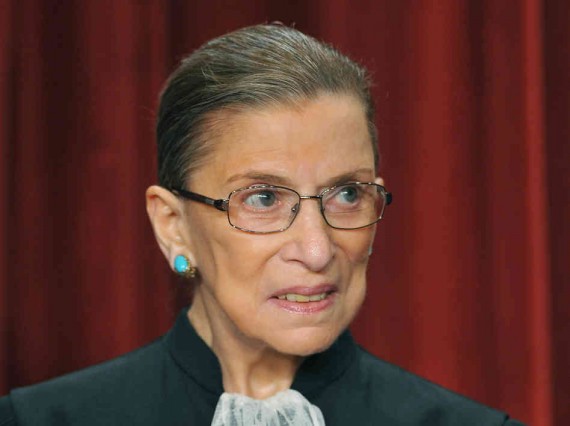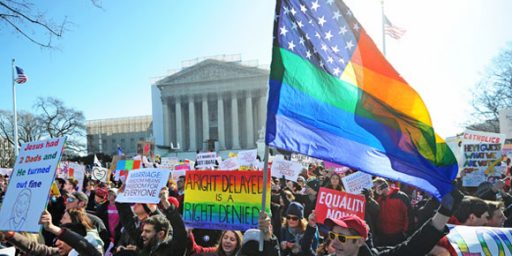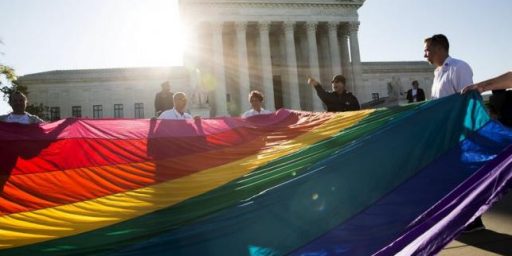Ruth Bader Ginsburg: Roe v. Wade Went Too Far
Justice Ginsburg made some interesting comments about Roe v. Wade recently. Could they be a signal about where the Court is headed on gay marriage?
Before she became a Judge, Ruth Bader Ginsburg made her career as an strong advocates for women’s rights, primarily as the founder and lead counsel for the ACLU’s Women’s Rights Project, and argued several landmark cases before the Supreme Court. For that reason alone, her recent comments about the Court’s 1972 ruling in Roe v. Wade, which established a right to abortion under a wide variety of circumstances, were very interesting:
One of the most liberal members of the U.S. Supreme Court, Justice Ruth Bader Ginsburg could be expected to give a rousing defense of Roe v. Wade in reflecting on the landmark vote 40 years after it established a nationwide right to abortion.
Instead, Ginsburg told an audience Saturday at the University of Chicago Law School that while she supports a woman’s right to choose, she feels the ruling by her predecessors on the court was too sweeping and gave abortion opponents a symbol to target. Ever since, she said, the momentum has been on the other side, with anger over Roe fueling a state-by-state campaign that has placed more restrictions on abortion.
“That was my concern, that the court had given opponents of access to abortion a target to aim at relentlessly,” she told a crowd of students. “… My criticism of Roe is that it seemed to have stopped the momentum that was on the side of change.”
The ruling is also a disappointment to a degree, Ginsburg said, because it was not argued in weighty terms of advancing women’s rights. Rather, the Roe majority opinion, written by Justice Harry Blackmun, centered on the right to privacy and asserted that it extended to a woman’s decision on whether to end a pregnancy.
Four decades later, abortion is one of the most polarizing issues in American life, and anti-abortion activists have pushed legislation at the state level in an effort to scale back the 1973 decision.
Ginsburg would have rather seen the justices make a narrower decision that struck down only the Texas law that brought the matter before the court. That law allowed abortions only to save a mother’s life.
A more restrained judgment would have sent a message while allowing momentum to build at a time when a number of states were expanding abortion rights, she said. She added that it might also have denied opponents the argument that abortion rights resulted from an undemocratic process in the decision by “unelected old men.”
Ginsburg told the students she prefers what she termed “judicial restraint” and argued that such an approach can be more effective than expansive, aggressive decisions.
“The court can put its stamp of approval on the side of change and let that change develop in the political process,” she said.
The Court’s decision in Roe v. Wade has been the target of criticism virtually from the time the ink started to dry on the paper it was printed on. From the right, the decision is seen as the primary example of what is often referred to as “legislating from the bench,”a situation in which judges stray away from their proper role as interpreters of the law and the Constitution and begin using their decisions to set social policy. In the case of Roe, the argument goes, the Supreme Court created a right to abortion nationwide out of whole cloth with little regard for what the Constitution actually did or didn’t say on the topic. In the end, Roe is looked at with derision by judicial conservatives both because of this and because of the outcome of the case itself. There have also been criticisms of Roe from the left, most of them similar to what Ginsburg said regarding the matter. Some advocates of abortion rights have argued that Roe has actually hurt their movement more than it has helped because, for more than 40 years now, it has served as a rallying cry for the Pro-Life movement, a fact that can be seen every year on the anniversary of the decision itself when tens of thousands of people rally in Washington for the March for Life. Indeed, many political analysts have pointed to Roe as the catalyst for the politicization of Evangelicals and the development of groups such as Moral Majority (which has since disbanded but not before leading to the formation of countless other Evangelical political organizations , which have played an important role in American politics since the 1980s. Arguably, a more limited legal ruling from the Court in 1972 would have had a far less sweeping political impact.
Ginsburg’s specific argument here is an interesting one. As she notes, the Court that heard Roe did not have to issue the kind of broad ruling that it did back in 1973. The only issue before it was whether the Texas statute that banned all abortions except those necessary to save the life of the mother violated the rights of the Plaintiff, identified later as Norma McCorvey. They could have limited their decision simply to that issue rather than trying to set policy for the nation as a whole. Yes, it would have meant that the abortion rights movement would have had to take the time to expand abortion rights at the state level. However, it’s worth noting that, at the time Roe was handed down, many states had already either begun or completed the process of liberalizing their abortion laws thanks in no small part to the influence of the women’s rights movement, other states were getting ready to follow in their footsteps. By intervening to set national policy in one fell swoop, the Supreme Court halted that political process and imposed abortion policy on the nation as a whole at a time when the political debate about abortion rights had barely begun. As a result, it served to create an impression that abortion rights were imposed on the nation in an undemocratic manner, something that the pro-life movement has used to its advantage for decades now.
Inevitably, Court watchers will look at Ginsburg’s comments about a 4- year old case to see if it tells us anything about how Ginsburg herself, and the Court has a whole might be approaching any of the cases currently before it. Specifically, of course, this means the two cases that the Court heard back in March dealing with same-sex marriage. In the case dealing with California’s Proposition 8, for example, the Court has several options. It could, of course, uphold the law but that doesn’t seem very likely. The Court could also rule that the parties defending the case do not have standing to appeal the case. If that happened, someone would have to determine which decisions striking down the law is applicable, the District Court decision that struck the law down under reasoning that would essentially hold all laws against same-sex marriage to be unconstitutional, or the narrower decision from the 9th Circuit Court which relied primarily on the fact that California had essentially attempted to set up a “separate but equal” legal regime by limiting gay couples to civil unions rather than full marriage. Alternatively, the Court could simply adopt the 9th Circuit’s logic in which case the half dozen or so states that recognize civil unions but ban same-sex marriage would likely find their laws suffering the same fate as Proposition 8. Finally, the Court could issue a broad ruling that finds laws against same-sex marriage barred by the Equal Protection Clause under all circumstances, which would essentially be the same thing that Roe did vis a vis abortion rights.
Are Ginsburg’s comments a signal about which way she, or possibly the Court as a whole, might be leaning in this case? As a general rule, one should be cautious about trying to read Supreme Court tea leaves based on comments that a Justice has made in the past or the present. It could be the case that Ginsburg was simply expressing her own opinions about Roe without taking the Proposition 8 case into account. However, it is notable that she made these comments at the same time that she and her eight brethren are facing a decision that could potentially have the same kind of sweeping social and political impact that Roe has over the past 40 years. Looking back, Ginsburg says that she wishes the Roe court had been more circumspect in its ruling. That’s advice that could well be directed to the Court she is on today as it too struggles with an important case the implicates personal freedom, social policy, and long standing religious traditions. If it is a signal, then it arguably suggests that the Court is likely to take a more cautious approach than it did in January of 1973,
Author’s Note: The original version of this post inadvertently referred to Roe v. Wade as having been issued in 1972. It was, in fact, issued in 1973. I have corrected the references to the year of the decision and the passage of time in the interests of accuracy.







So… She doesn’t really disagree with it, she just thinks their reasoning was a little flawed?
Is delusion a sign of Alzheimers? Cause if so, we need to find a way to remove her from the SC soon. The only thing that would NOT have given the opponents of abortion something to aim at, was to not have made abortion legal in the first place. Really, what world is she living in?
Interesting piece Doug.
I certainly hope that the Court does not take the easy way out and leave it to the states to avoid equal protection for married couples. There is nothing admirable about avoiding a difficult decision simply because an interpretation of the constitution to the favor and benefit of gay marriage would anger 40% of the people.
Could the Court have gone the other way in order to avoid conflict with, say, Brown v Board? Avoiding a difficult decision does not make it easier down the road, it just means that down the road another Court will have the option to avoid a hard but just decision too.
@OzarkHillbilly: Is delusion a sign of Alzheimers? Cause if so, we need to find a way to remove her from the SC soon. The only thing that would NOT have given the opponents of abortion something to aim at, was to not have made abortion legal in the first place. Really, what world is she living in?
It helps if you actually red the article, chum.
Exactly. Instead of 50 separate fights, Roe v. Wade gave the pro-life side a unifying national rallying point. And by circumventing the democratic process, it gave them the argument that the people hadn’t had their say on the matter.
Immediate victory, but set the stage for decades of fighting. Kind of like the Treaty of Versailles, in a rather odd way.
i wonder if blackmun envisioned taking live babies out of a womb and deliberately killing them?
@bill: I believe that THAT was happening prior to Roe v Wade.
@al-Ameda: the 1st trimester thing, that got shot down later. not the coat hanger crowd stuff.
“My criticism of Roe is that it seemed to have stopped the momentum that was on the side of change.”
That’s a terribly unprincipled position. Ideally, judges should reach the verdicts that follow the correct interpretation of the law regardless of its political consequences. This statement does nothing but make Gingsburg look like a judicial activist who has little regards to the constitution. And no, I’m not a conservative or anything, I think that Scalia is no less bad and is basically just a culture warrior with no real constitutional philosophy
I think the big mistake in hindsight is essentially writing the trimester system into the abortion decision.
Science now has moved beyond the simplicity of trimesters but because the court gave us trimesters we are stuck with them.
I think it makes more sense to use viability and when life can be sustained outside the womb.
Ginsburg is arguing from a false premise. Opponents to abortion were outnumbered by abortion advocates, and, in fact, nearly all non-Catholic denominations applauded the Roe v. Wade decision. (And it wasn’t until 1869 that the RCC determined that abortion was explicitly murder, implicitly stating that life began at conception – an idea that heretofore was against Church doctrine).
Abortion opposition did not become a popular movement until the late 70s when guys like Schaeffer, Viguerie, and Falwell decided that politicizing abortion and the SC decision was a route to political power vis-á-vis Reagan and the Republican Party.
As for abortion itself, it is bizarre for anyone who supports property rights to seek undermining the foremost right of all – the autonomy of one’s body and mind. This is, above all, a human right.
@al-Ameda: 40%: In our state it is more likd 70%.
@nemerinys: Look up the term “quickening.” And remember that things like pregnancy tests, ulltrasounds, and the like have NOT been around since the dawn of time.
And property rights now include the right to kill someone you find on you own property? Even if their presence is not voluntary? And if, in most cases, they’re there as a direct consequence of your own willing actions?
One point that’s being overlooked here (as well as in much of the news coverage over her recent comments) is that these views of hers aren’t new; she expressed them before she was even appointed to the Court, and they were a source of controversy during her confirmation hearings. Here’s how a 1993 NYT article describes the matter:
@Tyrell:
I’m sure that there are many states where opposition to gay marriage is well over 50%, however I do not believe that that should be a basis for denying equal protection under the law to gay married couples. I do not believe that this is a states’ right.
@Jenos Idanian #13: How many body organs have you been forced to donate? When I can come along and lay claim to your kidney because it would support someone else, THEN I’ll start believing in your so-called “rights” doctrine.
Why is it that fertile women the only ones who have to have their body organs taken over as life support system for another entity? Why not men?
@Jenos Idanian #13: So if “willing actions” are the evidence by which we should determine medical treatment, I take it you’re fine with our not doing anything about people with lung cancer from smoking. Or a bike or motercycle rider who went out without a helmet.
Also, birth control doesn’t always work, even if you’ve done everything you’re supposed to. It would seem to me that in that case, you have an even stronger argument for an abortion. Right?
Of course, if you want to argue that this means all men are required to get sterilized, go ahead….
@Jenos Idanian #13:
I partially agree with this statement.
At the time of the Roe decision, four states allowed abortions only in the case of health dangers and rape/incest, four states legalized some form of on-demand abortions, and in two states voters had rejected ballot measures. So this is a case where the Supreme Court *might* have moved too early.
On the other hand, it becomes clear that these issues also reach an inflection point where, while the majority of the States have moved on a issue, certain States are unlikely to ever move in the foreseeable future.
The question is then what should be done in those cases. At what point have we moved to a point where broad federal intervention (either legislative or judicial) should occur.
Source on pre-Roe state info: http://www.ewtn.com/library/PROLIFE/LIFBFROE.TXT
Oops… need to correct my previous post. Wikipedia contradicts the source I listed above…
At the time of the Roe decision, sixteen states allowed abortions only in the case of health dangers and/or rape/incest, four states legalized some form of on-demand abortions, and in two states voters had rejected ballot measures. So this is a case where the Supreme Court *might* have moved too early with full legalization.
So the count is 20 states allowing abortion in cases of rape/incest and/or health dangers. So to my question above, should Roe, for example, have only made abortion legal in the case of health danger, rape and incest (which 20 different states allowed at the time) and have punted the “on-demand” issue?
Source on pre-Roe state info: http://en.wikipedia.org/wiki/Abortion_in_the_United_States#Legal_position_before_Roe — FYI, looking at the map its worth noting that Southern States, were, as a whole were more progressive than Northern States on this issue.
@Jenos Idanian #13:
“Quickening,” or when the woman can feel fetal movements, occurs anywhere between the 10th and 16th week; historically, abortion was accepted prior to the 12th or 13th week (the first trimester). FTR, some women who don’t realize they are pregnant (still have periods, weight is distributed around the body instead of just the belly) often mistake fetal movements for an upset stomach; with my first pregnancy, I didn’t realize I was pregnant until I went to the doctor for what I considered a lengthy case of stomach flu. On the other hand, I knew I was pregnant with my third child by the 5th week.
“Killing someone” depends entirely on whether a fetus is an individual person. Science cannot provide an answer, except to state that the fetus is utterly dependent on the woman’s body, and, thus, cannot survive outside of that body. Otherwise, the determination of ‘personhood’ is entirely subjective, whether of personal opinion and/or religious doctrine. Both of which, IMO, is subservient to the human right to freedom of conscience and to bodily autonomy.
this just in, apparently “something” was killed.